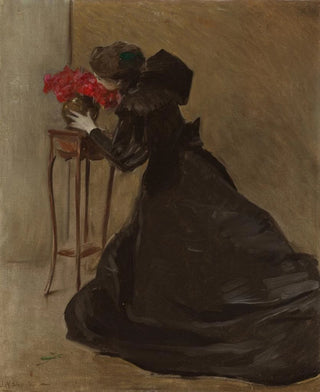Art print | Bronze bowl - John White Alexander


View from behind

Frame (optional)
John White Alexander's "Bronze Bowl" art print embodies the elegance and sophistication of an era where art and craftsmanship converged in perfect harmony. This piece, with its delicate curves and metallic sheen, captures the eye and evokes unwavering admiration. Gazing upon this work transports you to a universe where every detail has been meticulously crafted, where light interacts with the reflections of bronze to create an atmosphere that is both warm and intriguing. This art print, faithful to the original, allows appreciation of the full richness of Alexander's work while offering an entry point into the history of decorative arts.
Style and uniqueness of the art print
The style of "Bronze Bowl" art print is distinguished by its ability to blend functionality and aesthetics. Alexander, as an artist, had the gift of transforming utilitarian objects into true works of art. This piece, with its flowing forms and minimalist design, demonstrates impressive technical mastery. The artist skillfully plays with textures and nuances of the material, creating a piece that captures light in a unique way. Every curve, every detail reflects an artistic sensitivity that transcends the simple object, inviting viewers to reflect on the beauty of everyday life. The warmth of bronze, combined with the finesse of the motifs, gives this art print a timeless aura, making it as relevant today as it was at the time of its creation.
The artist and his influence
John White Alexander, an emblematic figure of the late 19th and early 20th centuries, made his mark through his innovative approach to decorative arts. Born in 1856, he developed within a rich artistic context where the Arts and Crafts movement and Art Nouveau influenced many creators. Alexander stood out for his ability to combine tradition and modernity, integrating elements of nature and organic motifs into his works. His work not only influenced his contemporaries but also left a lasting imprint on subsequent generations of artists. Exploring themes related to beauty and harmony, he contributed to redefining the place of the

Matte finish

View from behind

Frame (optional)
John White Alexander's "Bronze Bowl" art print embodies the elegance and sophistication of an era where art and craftsmanship converged in perfect harmony. This piece, with its delicate curves and metallic sheen, captures the eye and evokes unwavering admiration. Gazing upon this work transports you to a universe where every detail has been meticulously crafted, where light interacts with the reflections of bronze to create an atmosphere that is both warm and intriguing. This art print, faithful to the original, allows appreciation of the full richness of Alexander's work while offering an entry point into the history of decorative arts.
Style and uniqueness of the art print
The style of "Bronze Bowl" art print is distinguished by its ability to blend functionality and aesthetics. Alexander, as an artist, had the gift of transforming utilitarian objects into true works of art. This piece, with its flowing forms and minimalist design, demonstrates impressive technical mastery. The artist skillfully plays with textures and nuances of the material, creating a piece that captures light in a unique way. Every curve, every detail reflects an artistic sensitivity that transcends the simple object, inviting viewers to reflect on the beauty of everyday life. The warmth of bronze, combined with the finesse of the motifs, gives this art print a timeless aura, making it as relevant today as it was at the time of its creation.
The artist and his influence
John White Alexander, an emblematic figure of the late 19th and early 20th centuries, made his mark through his innovative approach to decorative arts. Born in 1856, he developed within a rich artistic context where the Arts and Crafts movement and Art Nouveau influenced many creators. Alexander stood out for his ability to combine tradition and modernity, integrating elements of nature and organic motifs into his works. His work not only influenced his contemporaries but also left a lasting imprint on subsequent generations of artists. Exploring themes related to beauty and harmony, he contributed to redefining the place of the






